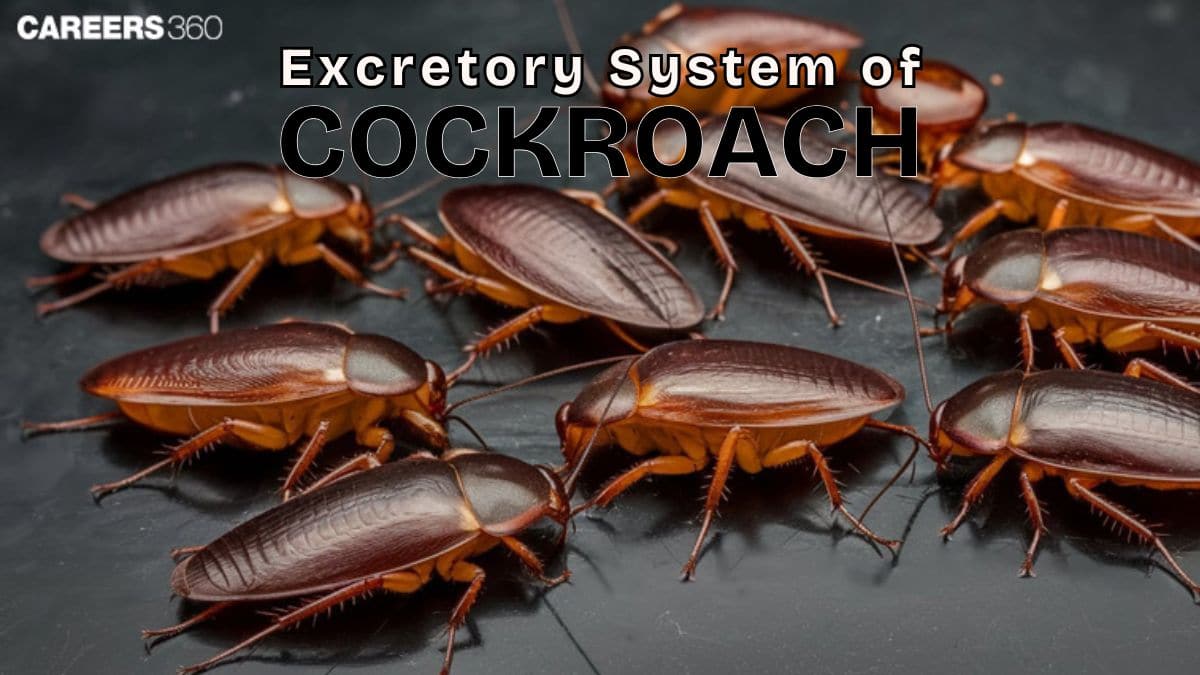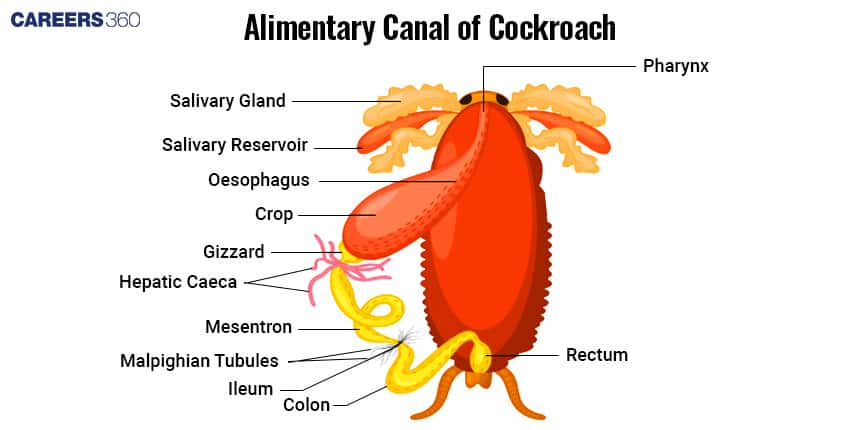Excretory System Of Cockroach
The excretory system of cockroach relies on Malpighian tubules and hindgut to remove nitrogenous wastes and conserve water. Studying the excretory system of cockroaches is essential, as it reveals adaptations that enable survival in terrestrial environments. A vital NEET and Class 11 Biology topic from Structural Organisation in Animals.
This Story also Contains
- What is the Excretory System of Cockroach?
- Anatomy Of The Cockroach Excretory System
- Mechanism of Excretion in Cockroach
- Comparison with Other Organisms
- Evolutionary Significance of Excretion in Cockroach
- Excretory System of Cockroach NEET MCQs (With Answers & Explanations)

What is the Excretory System of Cockroach?
The excretory system of the cockroach is a complex entity that plays a significant role in removing metabolic wastes and it helps to maintain proper balance of water and ions in the body.
It eliminates nitrogenous wastes from the body.
It maintains osmotic balance, thus regulating the water and ion concentration.
It converts toxic substances into less harmful compounds to excrete
It maintains overall homeostasis in the cockroach's body.
Anatomy Of The Cockroach Excretory System
The excretory system is responsible for waste removal and osmoregulation. It primarily includes Malpighian tubules and hindgut, which together control the excretion of nitrogenous waste and the inner balance between water and ions in the insect.
Malpighian Tubules
The Malpighian tubules are the first parts of the excretory system of cockroaches and perform the preliminary steps involved in processing waste.
Thin, tube-like structures penetrating the body cavity
Located at the junction between the mid-gut and hind-gut.
Each tubule is very long and coiled and floats freely in the hemolymph, the blood of insects.
Function:
Absorb waste products and excess ions from hemolymph
Transport these wastes to the hindgut for further processing
Initiate the process of transforming nitrogenous wastes into uric acid
Hindgut (Ileum, Colon, Rectum, Anus)
The hindgut, consisting of the ileum, colon, rectum and terminates at the anus, completes the excretion process through the reabsorption of nutrients and the elimination of waste.
Function:
The rectum contains specialised cells that reabsorb water and ions
Interacts with malpighian tubules and receives the filtrate
Concentrates the waste by reabsorbing water and useful ions
Excretes the dry uric acid as solid waste through the anus

Mechanism of Excretion in Cockroach
The excretory system of cockroaches efficiently processes and expels the waste and maintains internal equilibrium.
The excretion process in cockroaches consists of a sequential set of steps:
Filtration: Wastes are filtered from hemolymph by Malpighian tubules
Secretion: More wastes are secreted into the lumen by the tubules themselves.
Transport: Waste passes through the Malpighian tubules into the hindgut.
Filtration of Hemolymph
Thin, long and filamentous Malpighian tubules are present at the junction of the midgut and hindgut.
The Malpighian tubules are lined by glandular and ciliated cells.
Waste Collection
The glandular cells selectively absorb water, ions and nitrogenous waste from the hemolymph.
It equilibrates the ionic concentration by exchanging ions between hemolymph and tubules
Conversion of Ammonia to Uric Acid
The conversion of ammonia to uric acid is less toxic and insoluble.
Water is conserved by getting rid of solid uric acid that can be removed through waste elimination, making cockroach uricotelic.
Absorption and Reabsorption in Rectum
The waste products are passed into the ileum (part of hindgut)
Within the ileum and rectum, water and some inorganic salts are resorbed from the waste material.
It helps to conserve water which is crucial for survival in dry conditions.
Osmoregulation and Water Conservation
Osmoregulation in cockroaches is crucial for homeostasis.
Malpighian tubules regulate the concentration of ions through selective reabsorption and secretion.
Hindgut reabsorbs water based on the cockroach's needs.
Arid conditions cause no dehydration.
Maintains cellular function and total physiological balance.
Comparison with Other Organisms
Different organisms have evolved specialized excretory systems. While vertebrates use kidneys for excretion, cockroaches have malpighian tubules. Let’s take a look at the differences between the excretion systems of the two.
Vertebrates (Kidneys vs Malpighian Tubules)
Key Features | Cockroach Excretory System | Human Excretory System |
Main Structures | Malpighian Tubules, Hindgut (ileum, colon and rectum) | Kidneys, Ureters, Bladder, Urethra |
Waste Product | Uric acid | Urea |
Osmoregulation | Malpighian Tubules, Hindgut | Kidneys |
Water Conservation | Highly efficient, minimal water loss | Variable, depending on hydration status |
Insects (Aquatic vs Terrestrial)
The Malpighian tubules are utilised by most insects, such as ants and beetles, although their number and efficiency might vary.
Some aquatic insects excrete ammonia directly in contrast to terrestrial insects that excrete uric acid.
Evolutionary Significance of Excretion in Cockroach
The Malpighian tubule excretory system is ideally suited for life in dry environments and has contributed to the adaptive diversification of insects on land. Evolutionary changes in the excretory system occur per the ecological niche the insect occupies and the environmental adversities.
Excretory System of Cockroach NEET MCQs (With Answers & Explanations)
This topic carries a significant weightage in NEET exam. Important topics that should be focused are:
Diagram of excretory system
Functions of Malpighian tubules (Role in osmoregulation)
Comparison the excretory system of cockroaches with mammals.
Practice Questions for NEET
Q1. Cockroach is
Ammonotelic
Uricotelic
Ureotelic
All of these
Correct answer: 2) Uricotelic
Explanation:
The cockroach is uricotelic. Uricotelic refers to the excretion of nitrogen, mostly as uric acid. Uricotelic animals include reptiles and birds.
In cockroaches, the following structures help in excretion: Malpighian Tubules, Fat bodies, Nephrocytes, Cuticle, Uriose glands
Hence, the correct answer is option 2) Uricotelic.
Q2. Which one of the following statements is incorrect?
In cockroaches and prawns excretion of waste material occurs through malpighian tubules.
In ctenophores, locomotion is mediated by comb plates.
In Fasciola, flame cells help in excretion
Earthworms are hermaphrodites, and yet cross-fertilisation takes place among them.
Correct answer: 1) In cockroaches and prawns excretion of waste material occurs through malpighian tubules.
Explanation:
The expression, “In cockroaches and prawns excretion of waste material occurs through malpighian tubules” is incorrect because Malpighian tubules are excretory structures in most insects, including cockroaches, but green glands perform excretory functions in crustaceans like prawns. Rest all other statements are true.
Hence, the correct answer is option 1) in cockroaches and prawns excretion of waste material.
Q3. Malpighian tubules are present at the junction of
Forget and Midgut
Midgut and Hindgut
Crop and Gizzard
Ileum and Colon
Correct answer: 2) Midgut and Hindgut
Explanation:
Malpighian tubule is the main excretory organ & absorbs nitrogenous waste product followed by conversion into uric acid. Uric acid is exerted out into the hindgut. Malpighian is an analogue to the kidney in vertebrates. Malpighian tubules are found in insects and some arachnids, playing a vital role in osmoregulation and excretion. These tubules work in conjunction with the hindgut to maintain ionic balance and remove metabolic wastes efficiently. The excreted uric acid, being insoluble, helps conserve water, making it an adaptation for terrestrial life.
Hence, the correct answer is option 2) Midgut and hindgut.
Also Read:
Frequently Asked Questions (FAQs)
Malpighian tubules in cockroaches are thin tubes that filter wastes out of hemolymph; therefore, they act like excretory organs and perform the primary function of excretion and osmoregulation.
Wastes, in cockroaches, are excreted through Malpighian tubules that filter the hemolymph and pass it to the rectum, which expels it out in the form of uric acid.
It reabsorbs water and ions from the waste and concentrates it into a dry form and expels it out through the anus.
The selective reabsorption of water and ions in Malpighian tubules and rectum maintains the balance within the cockroach through osmoregulation.
Cockroaches seem to have adapted to the conservation of water very well by excretion of uric acid and efficient reabsorption of water and ions, developing a very effective tubular excretory system.